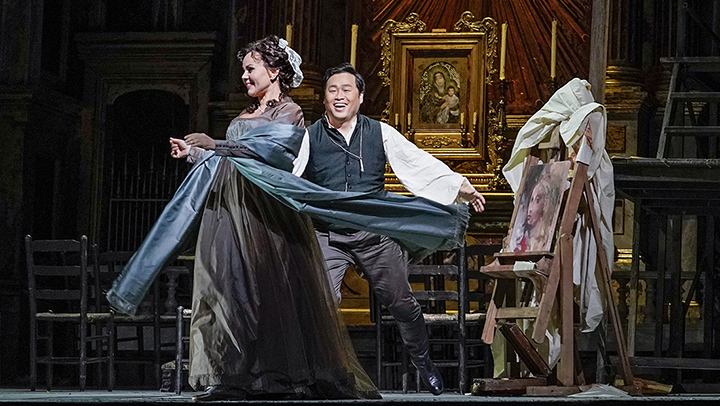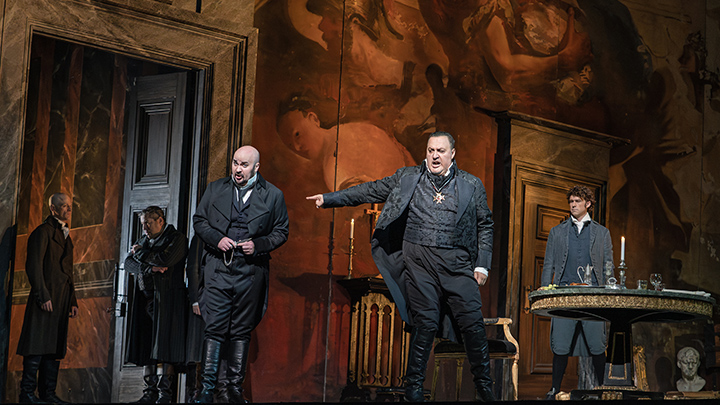“Angelia Jolie IS Maria Callas,” the posters proclaim. The imperious gaze of Angelina Jolie-as-Callas follows the passerby down Broadway, demanding assent. The leading lady’s chapeau and cheekbones are effective Divina drag. Still, only the final cut will tell if Jolie and the maestro of famous-female-suffering, Pablo Larraín, captured something of the woman whose name and image have become synonymous with “diva.”
If New Yorkers crave a more reliable hit of divadom in the meantime, they could do worse than catch this season’s opening run of Tosca at The Metropolitan Opera with Polish soprano Aleksandra Kurzak in the title role.
Kurzak, who recently celebrated her 100th performance at the Met, has transitioned from lyric and coloratura roles to the heavier verismo repertoire — her season consists largely of Puccini heroines with a notable debut in Giordano’s Fedora in Geneva. Judging from her performance last Saturday, the transition has mostly been successful. Her soprano remains slender at its uppermost extension but retains a pearlescent brightness across her register while revealing a surprisingly plush chest voice.
She seems intently aware of the limitations of her instrument against the thickness of Puccini’s orchestration; she never pushed the high notes, ensuring that her vibrato remained steady and aligned. Even if her approach meant that some of her vocal lines’ climaxes were less incisive, her sound remained attractive and possessed a delicacy that served her interpretative instincts well. She maintained a floated mezzo-piano throughout much of “Vissi D’arte” and allowed each phrase to settle gently, fostering a sense of intimacy. Still, by Act III, her voice had noticeably tired, and her narration of Scarpia’s murder felt haggard, especially when the vocal line leaped above the staff.
If her vocals sometimes lacked impact, her dramatic presence enlivened a revival that often felt dully routine. Kurzak understands that Puccini demands not only the ability to manage long phrases and musical outbursts but also to articulate each note with a consistent level of expressiveness and dramatic intensity. From her entrance into Sant’Andrea, she demonstrated a deep connection to the text, coloring each of her pronouncements to convey the heroine’s shifting moods. She had an easy charm; the coquettish, coy exchanges with Cavaradossi during their Act I duet felt less like affectations than genuine expressions of a woman in love’s delight. She even elicited a few chuckles from the audience as she hovered over Cavaradossi’s shoulder to ensure he painted la Maddalena with the correct eye color. “E avanti a lui tremava tutta Roma” came out in choked disbelief until a brief flash of pride came across her eyes. It made the ensuing staging of Scarpia’s corpse less of a macabre exercise in religious devotion than a testament to her accomplishment.

Korean tenor SeokJong Baek, fresh off his house debut in last year’s Nabucco, made a strong case for his continued presence on the Met’s roster. While his “Recondita armonia” lacked a degree of luster and elegance—he seemed to grasp at the notes from below, compromising the shape of the melodic line—his tenor warmed significantly by the end of the love duet. In the same duet, he demonstrated that he could scale back the power of his instrument to great effect; his cries of “mia sirena” had a honeyed sweetness that wafted over the orchestra. In what was perhaps the vocal highlight of the evening, he blasted out a “Vittoria!” for what felt like a dangerously long time with squillo to spare. It was an old-school indulgence to be sure, but one that merited the audience’s wild applause. The gentler, more lyrical side to his tenor returned in “E lucevan le stelle,” which he tinted with a restrained dynamic palette and some lovely diminuendos. He and Kurzak shared good chemistry, even if he could not quite match her level of dramatic intensity.
As Scarpia, Georgian baritone George Gagnidze had a rough evening. His sound stalled, never achieving the distinctiveness of color or volume needed to project the chief of police’s authority or vileness. His unvaried handling of the text and lack of heft largely stripped the Te Deum of its sublime sordidness, though The Metropolitan Opera Chorus revived the tension and ensured that one of Puccini’s most memorable set pieces retained its dramatic thrust. Gagnidze’s characterization consisted of broad gesturing and lunging into his marks. There was very little palpable connection between him and either of his costars; this became most apparent during the interrogation scene, where Baek, who had been animated in his exchanges with Kurzak, suddenly went blank in the presence of a character who should have provoked stronger reactions. His want of energy made Kurzak’s focus and intensity throughout the second act even more staggering.
Some of Gagnidze’s vocal troubles may be attributed to Xian Zhang’s opaque conducting in the first act. While her expressive phrasing and gesticulating brought out a spiky, anxious pulse that stressed the piece’s standing as a kind of operatic thriller, her handling of the orchestra, however commanding and cohesive a sound it provoked, often swamped the singers. Kevin Short as Angelotti and Patrick Carfizzi, no stranger to the Met’s acoustic demands, as the Sacristan both struggled to be heard. Zhang was more generous Kurzak, calibrating her dynamics to accommodate the limitations of her soprano. The Act III prelude was Zhang’s strongest moment, as she melded a shimmering array of matinal hues with an incessant, gnawing tinge of what that Roman dawn portends.
The David McVicar production, directed in revival by Sarah Ina Meyers, retains both its visual splendor and unimaginative blocking—the shawlography is still present, if somewhat reduced. Still, costumes by John Macfarlane and movement director Leah Hausman’s staging of Macaroni, nobles, and beggars filing into the nave of the cathedrals provide some period details to relish.
Two more divas will take on the shawl in Tosca this season: Lise Davidsen and Sondra Radvanovsky. Both will lend their distinctive vocal gifts to the role, but it remains to be seen whether they can approach Kurzak’s singular presence and dramatic commitment.
Photos: Karen Almond







Comments